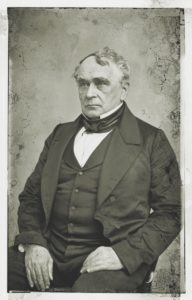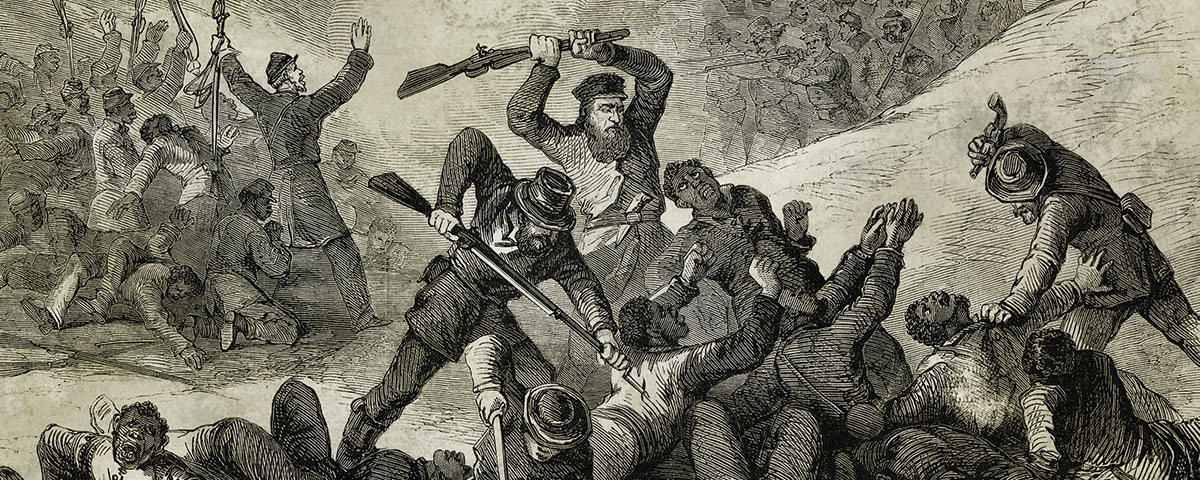In 1862, with the Civil War underway, Francis Lieber got the War Department to let him draft a new set of rules for the conflict.
IN THE DEVELOPMENT OF THE LAWS OF WAR IN THE 19TH CENTURY, the author of the most influential American document on the subject was Francis Lieber, a Prussian academic who had emigrated to the United States in 1827, changing his name from Franz to Francis on his arrival. In many respects, however, Lieber fully embodied the American character of the time, particularly as the country split apart in the Civil War. An ardent Unionist, he had spent nearly 20 years as a professor of history and political economics at South Carolina College (now the University of South Carolina) and thus understood Southern institutions and perspectives well enough to know why he vehemently disagreed with them. His personal life also reflected the great American tragedy of that war—his eldest son was killed fighting for the Confederacy, while his two younger sons served in the Union army.

Lieber was passionately interested in the legal questions that arose when armies had to operate in the midst of civilian populations, particularly ones that owed their allegiance to an enemy government. In this he was undoubtedly influenced by his own experiences in war: He had served as an infantryman in the Napoleonic Wars and was wounded twice at the Battle of Waterloo. Lieber knew firsthand the worst aspects of unrestrained warfare. During the first months of the Civil War officials of the army quickly realized that the existing framework of American military law was insufficient for the realities of the new conflict. At the outbreak of the war, for example, Union commanders made their own widely varying determinations of what they could or could not do in their efforts to control hostile civilians in Confederate territory. Some overstepped the bounds of their authority and issued blatantly unlawful orders that President Abraham Lincoln had to rescind. Major General Robert H. Milroy (a lawyer and judge), for example, tried to extort money from locals in retaliation for the army’s losses to Confederate guerrillas and threatened to execute any citizen who resisted. Others, including Major General George B. McClellan, initially took such a lenient approach to Confederate civilians that ardent Unionists accused them of sympathizing with slaveholders.
Lieber was already a recognized voice in the debate over the nature of lawful warfare. He kept up a voluminous correspondence with military leaders and politicians, in particular Henry Halleck, the general in chief of all Union armies during the Civil War and the foremost military legal theorist then in active service. Lieber repeatedly urged the creation of a code of military law that would address the new exigencies of this civil war and provide a binding legal framework for military operations. Writing to Halleck in November 1862, Lieber argued that the army desperately needed “a set of rules and definitions providing for the most urgent cases, occurring under the Law and Usages of War, and on which our Articles of War are silent.”
It was an innovative idea. War frequently involved civilian populations, both friendly and hostile, but no nation had yet attempted to codify the laws of war to address this specific problem. What Lieber proceeded to propose was, in fact, largely without precedent. “I do not know,” he wrote, “that any such thing as I design, exists in any other country, but in all other countries the Law of War is much more reduced to naked Force or Might.” When the War Department agreed to his proposal at the end of 1862 and formed a board to create such a document, it was hardly surprising that Lieber was appointed to the committee, along with three general officers.
For Lieber, two concepts were paramount in the creation of this new legal code. One was a recognition and acceptance of the doctrine of total war; the other was the idea of military necessity. He didn’t have much of a foundation on which to base his code. Searching through centuries of treatises on laws of war, including the seminal work of Hugo Grotius and Emmerich de Vatel, he ruefully noted that “nearly everything was floating”—meaning that while many of the concepts and ideas he used had been expressed by other scholars, no one had compiled them into a single legal document that adequately applied lawful restraint to the demands of modern warfare.
Even so, it took Lieber less than three months to produce a draft of his code. Lincoln approved the final document, titled Instructions for the Government of Armies of the United States in the Field, and the War Department published it on April 24, 1863, as General Orders No. 100. For the rest of his life, Lieber would refer to it as the “Old One Hundred.”
Lieber’s code was a revolutionary approach to the complexities of lawful warfare. It was not written for lawyers, but was clearly intended for serving officers, who would not be expected to have any formal legal training to guide them through the dense thickets of a conventional treatise. The code’s language is clear, concise, and completely utilitarian—no convoluted sentences cluttered with Latin phrases appear anywhere in its 157 paragraphs or articles. Although Lieber was the only civilian on the board appointed by the War Department to draft the code, there is no question that the final result completely reflected his philosophy and intent.
While Lieber’s code attempted to prevent unnecessary loss of life and destruction of private property by placing clear legal constraints on military actions, it still accommodated the harsh realities of military necessity. The driving force behind this concept was Lieber’s belief that in time of civil war such a code was essential for saving the country, and that this was the only true purpose of any military action. Writing to Senator Charles Sumner of Massachusetts a year before the code was published, Lieber stated that the goal of saving the United States from permanent rupture was the only thing that mattered in the war. “Everything that may interfere with this, however good in itself,” he wrote, “must be put aside.”
Lieber, however, was not urging war without restraint. On the contrary, he believed that total war, war waged against every aspect of the enemy’s structure, was the only way to fight, so long as it was prosecuted within the recognized limitations of lawful warfare. “The more vigorously wars are pursued the better it is for humanity,” he wrote in the code. “Sharp wars are brief.” This was the cornerstone of his definition of the doctrine of military necessity, which Article 14 of the code defined as “those measures which are indispensable for securing the ends of the war, and which are lawful according to the modern law and usages of war.” While the code was a significant step toward regulating the brutality of war, it still allowed for some harsh military actions.
Article 27, for example, states that “the law of war can no more wholly dispense with retaliation than can the law of nations.” That proviso opened the door for a host of possible abuses, such as retributions against civilian populations for guerrilla attacks, or the burning of an entire town if someone in it fired on troops as they passed. Indeed, exactly those sorts of retributive actions were carried out by U.S. troops during the Philippine-American War in 1899 and by the German army in Belgium in World War I. Both armies cited the precepts of General Orders No. 100 as justification. What commanders in those later incidents chose to ignore, however, were the following passages in Lieber’s code, where he cautioned that “unjust or inconsiderate retaliation removes the belligerents farther and farther from the mitigating rules of regular war, and by rapid steps leads them to the internecine wars of savages.” In this he directly invoked the work of Vatel a century before him, who wrote, “If you once open a door for continual accusation of outrageous excess in hostilities…the sword will never be sheathed till one of the parties be utterly destroyed.” The code also explicitly stated that if the enemy’s forces refused to accept the surrender of U.S. soldiers, then neither was the U.S. Army required to accept their enemies’ surrender, a policy that would today violate recognized laws of war.
Lieber’s code laid out clear guidelines for commanders in the field for a range of military situations: occupying the enemy’s country; imposing martial law on a civilian population; the treatment of prisoners of war; the army’s responsibilities toward noncombatants; and, of particular importance to the war for which the code was written, how the U.S. Army was to deal with slaveholders and slaves. Despite its occasional allowances for practices that have since come to be regarded as unacceptable in lawful warfare, the code was groundbreaking in its scope and also, from a humanitarian standpoint, in its first, tentative steps to regulate the brutality of total war.
Lieber wrote his code specifically for the U.S. Army during a time of civil war, but it remained in force in the American military well past the Spanish-American War in 1898 and influenced later manuals. When it was replaced by the Rules of Land Warfare, published by the U.S. War Department in 1914, the preface to that document stated, “Everything vital in G. O. 100…has been incorporated in this manual.” The code also had tremendous influence
internationally on the development of laws of war. In 1866 it was reproduced almost verbatim in Johann Kaspar Bluntschli’s German text, which was adopted as Prussia’s governing manual of lawful warfare, and it was cited in new codifications for the armies of France, Great Britain, Italy, and Spain. At the Brussels Peace Conference of 1874, Lieber’s code was the framework on which the 15 attending nations based their legal discussions. His code was also cited as the inspiration for The Hague Conventions of 1899 and 1907, from which the modern constructs of internationally recognized laws of war arose. Indeed, as late as 1945 the Lieber code was still invoked in the U.S. Army’s policies in its role as an army of occupation in postwar Germany and Japan.
Ironically, for all of Lieber’s impact on the modern laws of war, he did not have a background in law—his doctorate degree was in mathematics, and as a professor he taught history and political science. A soldier in his youth, twice imprisoned by the Prussian government as “an enemy of the state,” he found his ultimate purpose in the civil war that threatened to tear apart his adopted country. His approach to the laws of war was clearly reflected in his personal motto: Nullum jus sine officio, nullum officio sine jure (No right without its duties, no duty without its rights). Lieber died in 1872, but his work on the laws of war influenced the subject well into the next century—and earned him a place in history. MHQ
JOHN A. HAYMOND is the author of The Infamous Dakota War Trials of 1862: Revenge, Military Law, and the Judgment of History (McFarland & Company, 2016).
[hr]
This article appears in the Summer 2018 issue (Vol. 30, No. 4) of MHQ—The Quarterly Journal of Military History with the headline: The Code Maker
![]()





